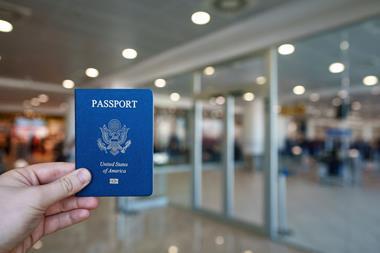Discovery of a way to make water bounce off surfaces faster could be used to stop ice forming on jet engines
US researchers have discovered a simple way to modify a water-repellent surface so that bouncing drops of water spend significantly less time in contact with the surface. The finding could have applications where the contact time between a drop and the surface is important, the researchers suggest, such as in freezing rain impinging on an aircraft’s engine.
When a drop of water strikes a superhydrophobic surface, such as a lotus leaf, it flattens and spreads out like a pancake before the edges begin to recoil, engulfing the centre and re-forming a spherical drop that then takes off again. The conventional approach to reduce the contact time between the drop and surface has been to reduce the interactions between the two. Theoretically there is a minimum contact time which occurs when there is zero interaction between the drop and the surface.
Now, however, a team led by Kripa Varanasi at the Massachusetts Institute of Technology has found a way to reduce contact time to below the theoretical limit. The team’s solution was to pattern a superhydrophobic surface of fluorosilane with small ridges whose height are slightly less than the thickness of the water film produced by the flattened drop. As the drop hits the surface and spreads out over a ridge, the portion of the water film that lies over the ridge is thinner than the adjacent parts of the film lying on the surface. Because the film is thinner here, its mass is lower and it consequently retracts faster. This has the effect of ‘pinching’ the pancake into two droplets; the retracting edges of these ‘sub-droplets’ have to cover much smaller distances as they reform and bounce away, reducing the contact time significantly. ‘In the case of the simplest geometry we get a reduction in contact time of around 40%,’ says Varanasi. ‘Can we get 80 or 90%? This is something we are working on.’
The researchers have found similar ‘macroscopic’ structures on natural surfaces, such as butterfly wings and leaves, but Varanasi says that to ascribe to these structures a function in reducing water droplet contact time is, at this stage, speculative.
‘This paper is one of those that makes you kick yourself; the idea behind it is simple and should have been obvious, but didn’t seem so before it was revealed,’ says Neil Shirtcliffe, who researches superhydrophobic surfaces at Rhine-Waal University of Applied Sciences in Germany. ‘This idea is not really a new approach to superhydrophobicity, it is a new way in which superhydrophobicity could be used to manipulate drops of water and super repellence could be used to manipulate any other liquid.’






No comments yet